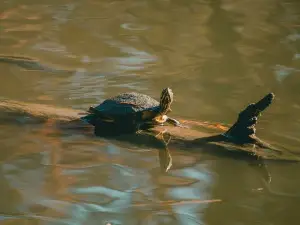
Turtles may be slow but this doesn’t mean that these animals aren’t aggressive and won’t bite each other, one place that a turtle may bite another is its tail
This is a quick guide on what to do if your turtle’s tail is bitten off.
Table of Contents
My turtle’s tail got bitten off
Turtles need their tails, this part of the animal’s body plays a role in reproduction, is important when a female is about to lay eggs, helps with balance, and keeps the cloaca protected.
So, if something happens to your turtle’s tail, if the tail is bitten off, then you’d understandably start to worry.
Here is what you need to know if your turtle’s tail is bitten off:
How this happened:
Your pet’s tail will never fall off on its own, it will usually be bitten off by a larger turtle in the enclosure. This is common to see in pet stores where a variety of turtles share an enclosure.
The animals will bite each other’s tails when competing for food or territory. Older turtles are more prone to bite younger turtles as older turtles are less docile and have pent-up frustration.
This can also happen when adult turtles and younger turtles are kept together. The adult turtle may mistake the smaller turtle’s tail for a piece of food, bite it, and even bite it off.
Tail biting will not always result in the tail being bitten off, it can also lead to intense stress in your pet.
What to do:
Taking your pet to the vet, or better yet, to a reptile vet or an exotic animal vet, is recommended, the vet will examine the remaining part of the tail, treat it, and offer antibiotics if need be.
If you can’t immediately get your pet to the vet then separating the animals should be the first thing you should do.
Removing the aggressor turtle and placing it in a separate enclosure may be easier than moving the injured turtle.
When separating your pet, remove the reptile from the water and dry dock it for 3-4 hours at a time.
Let the animal get into the water again for 30 minutes so it can go to the toilet and eat, then dry dock your pet again.
Once this is done clean the wound at the tail using povidone iodine or silver sulfadiazine.
Rinse the medicine off before you put the animal back into the water then apply again once your pet is out of the water.
If you don’t clean the wound then this can lead to the animal developing septicemia which is a deadly disease.
After cleaning, leave your pet somewhere warm in a box with paper towels at the bottom. Allow your pet to get 2 minutes of swim time a day twice a day as her daily exercise.
Keep your pet in here once you get it to the vet.
If you’re using turtles of different ages and sizes keep an eye on the animals to ensure that the larger ones don’t bite the tails of the smaller ones.
Your pet’s tail may grow bigger as the animal grows but the broken tip will not regenerate.
If you enjoyed this article then you may also be interested in other turtle/tortoise related articles. Here are some articles that you may be interested in: Why Is My Turtles Skin Red On The Sides?, Dents In Turtle Shell, Turtle Bleeding From Mouth, Turtle Shell Soft Around Edges, Deformed Turtle Shell Care, Deformed Turtle Shell, Turtle Missing Part Of Shell, Why Is My Turtle Losing His Shell?

